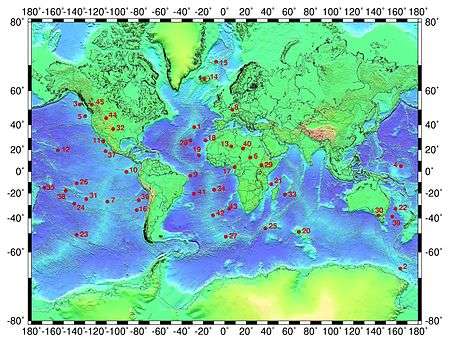Louisville hotspot

The Louisville hotspot is a volcanic hotspot responsible for the volcanic activity that has formed the Louisville Ridge in the southern Pacific Ocean.
Location
The Louisville hotspot is believed to lie close to the Pacific-Antarctic Ridge, although its exact location is uncertain.[1]
Geological history
The Louisville hotspot has produced the Louisville Ridge, which is one of the longest seamount chains on Earth, stretching some 4,300 km (2,672 mi)[2] from the Pacific-Antarctic Ridge where it subducts under the Indo-Australian Plate as part of the Pacific Plate.
The Louisville hotspot is believed to have been active for at least 80 million years based on age of the Louisville Ridge, which is comparable to that of the Hawaiian-Emperor seamount chain, although the rate of volcanism at the two chains are relatively different and the Louisville Ridge has a relatively small bend compared to that in the Hawaiian-Emperior chain.[1] During the Early Oligocene period, the Louisville hotspot's magma source rate was much steadier than the Hawaii hotspot rate, and had a lower total volume in eruption. During the Late Oligocene, the magma source decreased to a small fraction of that in the Hawaiian-Emperor seamount chain, such that none of the volcanoes has emerged above sea level in the past 11 million years. The Louisville Ridge is only half as wide as the Hawaiian-Emperior seamount chain. Therefore, unlike the Hawaii hotspot, the Louisville hotspot is believed to have decreased in activity with time.[1]
The Louisville hotspot may have created the Ontong Java Plateau, the world's largest oceanic plateau, around 120 million years ago. The modelled locations of the plateau and hotspot at the time do not coincide under one recent plate reconstruction, arguing against this, although other factors mean their linkage may still be possible.[3]
See also
- Christmas Island Seamount Province
- Osbourn Seamount the oldest of the Louisville Ridge
References
- 1 2 3 Condie, Kent C. (2001). Mantle Plumes and Their Record in Earth History. Cambridge University Press. p. 19. ISBN 0-521-01472-7.
- ↑ Vanderkluysen, L.; Mahoney, J. J.; Koppers, A. A.; and Lonsdale, P. F. (2007). Geochemical Evolution of the Louisville Seamount Chain, American Geophysical Union, Fall Meeting 2007, abstract #V42B-06.
- ↑ Antretter, M.; Riisager, P.; Hall, S.; Zhao, X.; and Steinberger, B. (2004). Modelled palaeolatitudes for the Louisville hot spot and the Ontong Java Plateau, in Origin and Evolution of the Ontong Java Plateau Geological Society, London, Special Publications, v. 229, p. 21-30. doi:10.1144/GSL.SP.2004.229.01.03.